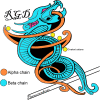Integrins and their potential roles in mammalian pregnancy
- PMID: 37679778
- PMCID: PMC10486019
- DOI: 10.1186/s40104-023-00918-0
Integrins and their potential roles in mammalian pregnancy
Abstract
Integrins are a highly complex family of receptors that, when expressed on the surface of cells, can mediate reciprocal cell-to-cell and cell-to-extracellular matrix (ECM) interactions leading to assembly of integrin adhesion complexes (IACs) that initiate many signaling functions both at the membrane and deeper within the cytoplasm to coordinate processes including cell adhesion, migration, proliferation, survival, differentiation, and metabolism. All metazoan organisms possess integrins, and it is generally agreed that integrins were associated with the evolution of multicellularity, being essential for the association of cells with their neighbors and surroundings, during embryonic development and many aspects of cellular and molecular biology. Integrins have important roles in many aspects of embryonic development, normal physiology, and disease processes with a multitude of functions discovered and elucidated for integrins that directly influence many areas of biology and medicine, including mammalian pregnancy, in particular implantation of the blastocyst to the uterine wall, subsequent placentation and conceptus (embryo/fetus and associated placental membranes) development. This review provides a succinct overview of integrin structure, ligand binding, and signaling followed with a concise overview of embryonic development, implantation, and early placentation in pigs, sheep, humans, and mice as an example for rodents. A brief timeline of the initial localization of integrin subunits to the uterine luminal epithelium (LE) and conceptus trophoblast is then presented, followed by sequential summaries of integrin expression and function during gestation in pigs, sheep, humans, and rodents. As appropriate for this journal, summaries of integrin expression and function during gestation in pigs and sheep are in depth, whereas summaries for humans and rodents are brief. Because similar models to those illustrated in Fig. 1, 2, 3, 4, 5 and 6 are present throughout the scientific literature, the illustrations in this manuscript are drafted as Viking imagery for entertainment purposes.
Keywords: Humans; Implantation; Integrins; Pigs; Pregnancy; Rodents; Sheep.
© 2023. Chinese Association of Animal Science and Veterinary Medicine.
Conflict of interest statement
The authors declare that they have no competing interests.
Figures






References
-
- Hynes RO, Ruoslahti E, Springer TA. Reflections on integrins – past, present and future. JAMA. 2022;328:1291–1292. - PubMed
-
- Burke RD. Invertebrate integrins: structure, function, and evolution. Int Rev Cytol. 1999;191:257–284. - PubMed
-
- Hughes AL. Evolution of the integrin alpha and beta protein families. J Mol Evol. 2001;53:63–72. - PubMed
-
- Hynes RO, Zhao Q. The evolution of cell adhesion. J Cell Biol. 2000;150:F89–96. - PubMed
Publication types
Grants and funding
LinkOut - more resources
Full Text Sources
Research Materials

